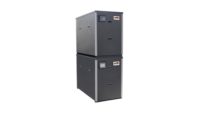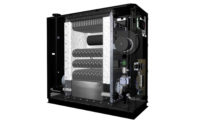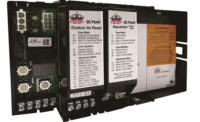On average, 15% of a commercial modulating/condensing boiler’s runtime is spent at high-fire, according to Jim Schnorr, president of Lancaster, Pa.-based Thermal Solutions Products. The unit coasts along at medium- or low-fire for the other 85% of the time. This is the “sweet spot” in which the unit is condensing, providing the high efficiency it was designed for.
Ideal condensation — which facilitates high-efficiency operation — occurs in the heat exchanger when the difference between supply and return water temperatures (Delta-T) is near or greater than 20° F.
To maximize the amount of time a boiler condenses, the flow rate through the heat exchanger also should modulate along with the boiler’s firing rate. Currently, the industry prefers a fixed-speed circulator sized to provide the correct flow rate and desired Delta-T at high-fire only. This makes it impossible to provide ideal flow at lower burner inputs.
Schnorr notes that hydronic systems can benefit from variable-speed technology 51 minutes out of every hour of firing. Simply put, we are over-pumping.
Until recently, changing the flow rate through a light commercial boiler to match the Btu input has largely been an afterthought. Only a few boiler manufacturers offered it as an option last year. The general consensus seemed to be it simply isn’t economical to pay for the upgraded variable-speed circulator. But in October 2015, an intelligent collaboration between two hydronic manufacturers emerged to greatly expand and refine the capability.
“We lost a number of large jobs based on an electrical savings that our competitor could claim through the use of an ECM-powered variable-speed boiler pump,” Schnorr says. “We began developing the technology for our own boilers out of necessity.”
The bigger picture: Conserving gas
Up to this point, the conversation about using a variable-speed circulator as a boiler pump has revolved entirely around electric efficiency. Based on the inherent efficiency of ECM motors and the ability to run at much lower speeds, its true electric consumption falls significantly, as much as 86% according to Schnorr. But in the grand scheme of things, it’s only one circulator.
“The real advantage is fuel savings,” Schnorr explains. “Our new variable-speed boiler pump kit, called Eco-Propel, has consistently yielded up to a 3% reduction in gas consumption by increasing heat transfer at low- and mid-fire rates where over-pumping limits condensing performance.”
Three percent might not sound like much, but when assigning a dollar value to the gas that an 825 MBH boiler uses over the course of a year — or several for that matter — the savings quickly stack up. This is the catalyst and justification for using variable-speed technology on condensing boilers and it seems to have gone unnoticed until now.
While testing the Eco-Propel kit, Schnorr notes, Thermal Solutions consistently found a 6° to 10° reduction in return water temperatures over the course of a firing cycle. Each degree is critical in producing as much condensate as possible. More heat stays in the system, while less goes out the stack.
Ultimately, the result was an all-inclusive, plug-and-play boiler pump package that provides a 12-month payback in the Northeast based on heating degree days and fuel prices. Payback varies in other parts of the country, but is seen, at most, around two years out.
Circulator adaptation
It began last year, when Schnorr worked with Taco experts to select and modify an ECM circulator for the task. Meanwhile, Thermal Solutions engineers Ronak Patel and Henok Abebe began development of the Eco-Propel kit that would allow the Apex boiler’s control system to interface accurately and continuously with the circulator.
“When Thermal Solutions first approached us about this project, our engineering department looked at the pump requirements and found Taco’s ECM-powered VR15 offered the correct performance curves,” Taco’s OEM Business Development Manager John White III says. “The circulator’s broad operating range makes it ideal for a modulating boiler that’s capable of a wide variation in heat input.”
The only hurdle was the pump’s ability to receive a 0-10v signal. Taco’s had that capability for several years, but had not yet implemented it on the 00e line of high-efficiency circulators because the demand didn’t justify it. This was the same challenge Thermal Solutions was finding with other pumps available in the same category.
At roughly the same time, Thermal Solutions began discussions with Taco engineers in Lancaster who already were testing another commercial ECM circulator for adaptation. The pump’s controls proved to be too cumbersome and required commissioning upon startup even in a typical installation.
Taco’s long-standing relationship with Thermal Solutions was reason enough to quickly put the wheels in motion. While Taco engineers modified the circulator in Cranston, R.I., engineers at Thermal Solutions were busy with the other half of the solution.
“At the very beginning of this project, we attempted to run the variable-speed pump with a set of temperature sensors on the supply and return pipes,” Patel explains. “While these sensors work well within a distribution system, there was a slight lag time that we weren’t willing to tolerate for this application, plus there was the possibility of firing rate and pump flow fighting each other. That’s when we decided everything must be orchestrated through the Apex boiler’s control.”
Savings trifecta
“In actuality, there are three ways that the Eco-Propel kit conserves resources,” Schnorr says. “Annual electrical and gas savings are easy to quantify; $245 and $600, respectively, in the Northeast. The last benefit, boiler longevity, is just as real, but more difficult to quantify.”
By reducing the number of boiler cycles and limiting thermal shock to the heat exchanger, the use of a variable-speed boiler circulator extends the service life of the condensing boiler. In addition to boiler longevity, circulator life also is extended. This is due to slower motor operation during the vast majority of runtime hours.
The electrical savings provided are enhanced by the water-tube heat exchanger. Its design provides a 40% lower pressure drop than any other water-tube heat exchanger currently on the market, permitting lower flow rates and higher Delta-Ts and finely tuning system efficiency, Schnorr states. And for the installer, there’s one more benefit unique to the kit. Because the simplicity of the controls used on the Taco VR15, paired with the capability built into the Concert Boiler Control, all setup and modifications are done through the boiler’s touchscreen interface. Schnorr claims there’s no other system available that’s as intuitive or user friendly.
For everyone involved in the supply chain, stocking and purchasing the Eco-Propel kit is simple. One box covers the entire Apex boiler line. Because the kit includes every component needed, there’s no room for error.
The future is now
Thermal Solutions anticipates the industry is moving from fixed-speed/variable-speed systems (boiler loop/distribution) to variable-speed/variable-speed. This especially is true on commercial projects. Over the past several years, engineers and installers in the U.S. and Canada have grown comfortable with variable-speed distribution and its benefits. But as buildings become more efficient, flow rates are reduced and supply temperatures fall, there’s a real need for the boiler to respond accordingly.
“This is definitely what the hydronic industry needs to maintain its competitive advantage,” Schnorr says. “And in many places, variable-speed boiler circulators are likely to be incentivized, if they’re not already. We’re currently looking into how this technology fits under the existing utility programs throughout New England and California.”
This article was originally titled “A new way” in the December 2016 print edition of PM Engineer.





